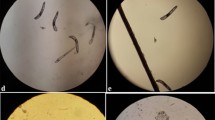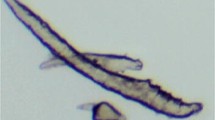Abstract
The aim of the study was to investigate the presence of Demodex in the hair follicles of eyelashes and their potential participation in the aetiology of chalazion in patients in Poland. The study of the correlation between the presence of Demodex spp. and chalazion has never been performed in patients in Europe. There is, therefore, a justified necessity to check whether Demodex mites can be a potential risk factor in the development of chalazion in the European population. The samples were examined by light microscope, using standard parasitological methods. A positive result was assumed in the presence of Demodex spp. Demodex was detected in 91.67% of patients with a chalazion. The presence of Demodex was found in subjects from all examined age groups. The results of statistical analysis unambiguously determined the existence of an interrelationship between the presence of Demodex and chalazion. Our results clearly indicate the existence of a correlation between the occurrence of Demodex spp. and chalazion. Confirmation of the positive correlation between Demodex and chalazion in a European population provides further evidence for the pathogenic role of Demodex in the development of eye diseases.
Similar content being viewed by others
References
Akbulatova L.K. 1963. The pathogenic role of Demodex mite and the clinical form of demodicosis in man. (in Russian). Vestnik Dermatologii i Venerologii, 40, 57–61
Akilov O.E., Mumcuoglu K.Y. 2003. Association between human demodicosis and HLA class. Journal of Clinical and Experimental Dermatology, 28, 70–73
Baima B. Sticherling M. 2002. Demodicidosis revisited. Acta Dermato-Venerologica, 82, 3–6
Bonnar E., Eustace P., Powell F.C. 1993. The Demodex mite population in rosacea. Journal of the American Academy of Dermatology, 28, 443–448
Bradford C.A. (Ed.) 2004. Basic Ophthalmology. 8th Edition. American Academy of Ophthalmology. USA. pp. 219
Browning D, Proia A. 1986. Ocular rosacea. Survey of Ophthalmology, 31, 145–158
Desch C., Nutting W.B. 1972. Demodex folliculorum (Simon) and Demodex brevis (Akbulatova) of man: redescription and reevaluation. Journal of Parasitology, 58, 169–177
Desch C., Nutting W.B. 1977: Morphology and functional anatomy of Demodex folliculorum (Simon) of man. Acarologia, 19, 422–462
v. Hippel E. 1932. Demodex folliculorum im Chalazion. Albrecht von Graefes Archiv für Ophthalmologie, 129, 198–204
Humiczewska M. 1991. Demodex folliculorum and Demodex brevis (Acardia) as the factors of chronic marginal blepharitis. Wiadomosci Parazytologiczne, 37, 127–130
Jarmuda S., O’Reilly N., Zaba R., Jakubowicz O., Szkaradkiewicz A., Kavanagh K. 2012. Potential role of Demodex mites and bacteria in the induction of rosacea. Journal of Medical Microbiology, 61, 1504–1510. DOI: 10.1099/jmm.0.048090-0
Kamoun B., Fourati M., Feki J., Mlik M., Karray F., Trigui A., Ellouze S., Hammami B., Chaabouni M., Ayadi A. 1999. Blepharitis due to Demodex: myth or reality? (In French). Journal français d’ophthalmologie, 22, 525–527
Kanski J.J., Bowling B. (Eds). 2011. Clinical Ophthalmology: A Systematic Approach. 7th Edition. Elsevier Health Sciences, USA, pp. 920
Kligman A.M., Christensen M.S. 2011. Demodex folliculorum: requirements for understanding its role in human skin disease. Journal of Investigative Dermatology, 131, 8–10. DOI: 10.1038/jid.2010.335
Lacey N., Delaney S., Kavanagh K., Powell F.C. 2007. Mite-related bacterial antigens stimulate inflammatory cells in rosacea. British Journal of Dermatology, 157, 474–481
Lacey N., Kavanagh K., Tseng S.C. 2009. Under the lash: Demodex mites in human diseases. Biochem (Lond), 31, 2–6
Lacey N., Ni Raghallaigh S., Powell F.C. 2011. Demodex mites-commensals, parasites or mutualistic organisms? Dermatology, 222, 128–130. DOI: 10.1159/000323009
Liang L., Ding X., Tseng S.C. 2014. High prevalence of Demodex brevis infestation in chalazia. American Journal of Ophthalmology, 157, 342–348. DOI: 10.1016/j.ajo.2013.09.031
Pena G.P., Andrade Filho J.S. 2000. Is Demodex really non-pathogenic? Revista do Instituto de Medicina Tropical de São Paulo, 42, 171–173
Raszeja-Kotelba B., Pecold K., Pecold-Stepniewska H., Dadej I. 2004. Ocular rosacea - current etiopathogenetic, clinical and therapeutic data, and a description of three cases. (In Polish). Advances in Dermatology and Allergology, 21, 144–150
Sönmez O.U., Yalçin Z.G., Karakeçe E., Çiftci I.H., Erdem T. 2013. Associations between Demodex species infestation and various types of cancer. Acta Parasitologica, 58, 551–555, DOI: 10.2478/s11686-013-0178-y
Wolf R., Ophir J., Avigat J., Lengy J., Krakowski A. 1988. The hair follicle mites (Demodex spp.) Could they be vectors of pathogenic microorganisms? Acta Dermato-Venereologica, 68, 535–537
Yam J.C., Tang B.S., Chan T.M., Cheng A.C. 2014. Ocular demodicidosis as a risk factor of adult recurrent chalazion. European Journal of Ophthalmology, 24, 159–63. DOI: 10.5301/ejo. 5000341
Author information
Authors and Affiliations
Corresponding authors
Rights and permissions
About this article
Cite this article
Tarkowski, W., Owczyńska, M., Błaszczyk-Tyszka, A. et al. Demodex mites as potential etiological factor in chalazion — a study in Poland. Acta Parasit. 60, 777–783 (2015). https://doi.org/10.1515/ap-2015-0110
Received:
Revised:
Accepted:
Published:
Issue Date:
DOI: https://doi.org/10.1515/ap-2015-0110




